Like rumbling thunderclouds or far-off explosions, the
muffled booms broke the silence as we reclined on a slope of pulverized lava
beads in a small passage near the top of a volcano in East Africa, nearly 3.2km
up into the night sky.
اضافة اعلان
It was 5am, and for six hours we had been scaling the
colossal, pyramid-shaped Ol Doinyo Lengai — through waist-high tufts of grass
in powdery ash, through loose rock and tight crevices and finally over hardened
lava flows so steep I had to climb on all fours. Now we were exhausted, resting
inside a fissure with chalky white walls. At sunrise, we would clamber the
remaining 15 minutes onto the rim of the crater.
Our bed of gravelly black lapilli was warm, as if heated by
an electric blanket. At my knee, a vent in the rock emitted swirls of steamy
gas.
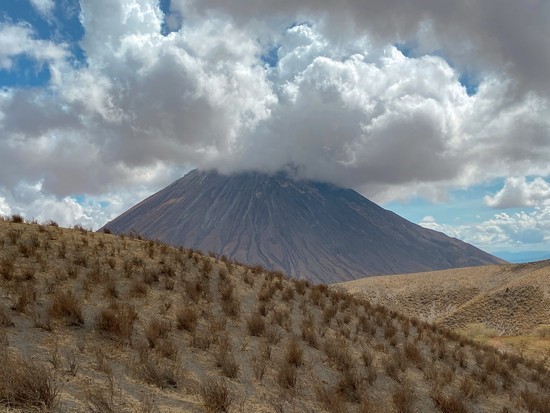 The cloud-topped
summit of Ol Doinyo Lengai, in Tanzania on November 11, 2022, an active volcano
that last exploded in 2008, looms over the crater highlands, with the outlines
of hardened lava flows striping the slopes.
The cloud-topped
summit of Ol Doinyo Lengai, in Tanzania on November 11, 2022, an active volcano
that last exploded in 2008, looms over the crater highlands, with the outlines
of hardened lava flows striping the slopes.
“You hear that noise?” my friend Kaixu Yuan asked.
“Yeah, it’s a thunderstorm in the distance,” I reckoned.
“That’s the volcano underground,” said Dennis Laiza, our
Maasai guide.
I was starting to understand what it actually meant to be
atop an active volcano.
We were nearing the spectacular climax of our grueling and
astonishing weeklong journey through the Crater Highlands of Tanzania. The
region sprawls along the East African Rift, where, millions of years ago,
separating tectonic plates allowed magma to rise, belching out over many
millenniums a multitude of volcanoes, many of them now collapsed calderas or
dormant peaks.
The most famous of the mountains is Kilimanjaro, the highest
point in Africa, 160km to the east. Kaixu had booked a flight from New York
with no set plan and wanted company. I am not a big fan of snow or thin air, so
I searched for an alternative adventure.
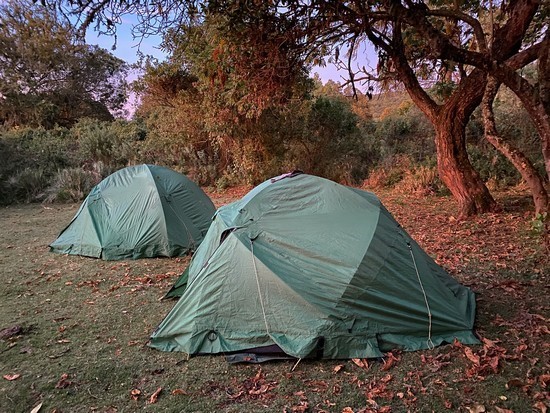 Dew-drenched tents
near the Maasai village of Nainokanoka, in Tanzania on November 10, 2022.
Dew-drenched tents
near the Maasai village of Nainokanoka, in Tanzania on November 10, 2022.
I was intrigued by the highlands and selected a mix of
experiences: a safari in the Ngorongoro Crater, the world’s largest volcanic
caldera, 22km wide and said to contain an astounding abundance of wildlife; the
Empakaai Crater, nearly 6.5km across and one of the few in the region filled
with a lake; and Ol Doinyo Lengai, the only volcano in the world to emit natrocarbonatite
lava — dark gray, relatively cool (about 510 degrees Celsius) and fast-flowing.
I used Instagram to send out requests for guides and chose a
relatively new tour operator named Daudi Minde. We settled on a trip that would
include two nights camping, a 10-hour trek, and four nights in a hotel and
lodge, for $1,750 per person.
The tour was poles apart from luxury safaris with furnished
tents and balloon rides over the Serengeti. Daudi cobbled together freelance
guides, a borrowed, old Land Cruiser and no-frills accommodations for a trip
that took us to places we surely would have missed without the aid of local
specialists.
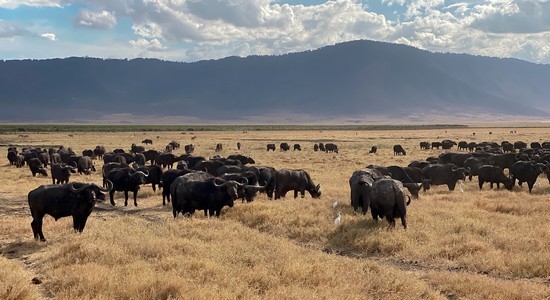 A herd of Cape
buffalo idles in the parched plains of the Ngorongoro Crater, in Tanzania on
November 9, 2022, at the tail end of the dry season.
A herd of Cape
buffalo idles in the parched plains of the Ngorongoro Crater, in Tanzania on
November 9, 2022, at the tail end of the dry season.
After landing in Kilimanjaro airport (I flew from Thailand,
where I live), we spent the night in nearby Arusha at the Green Mountain Hotel,
which, like most in the cities, was behind tall walls and a metal gate.
At 6:30am, our guide, Aidano Kayala, and cook, Ramadhan
Singano, had the Land Cruiser crammed with camping gear. We drove west past the
ramshackle shop fronts, women grilling corn on the dirt roadside and ranks of
young men on chrome-fronted motorcycles waiting for fares.
We knew we were in the wild when, two hours outside the
city, a bull elephant lumbered across the road, spun around and blared his
raised trunk, then rammed an acacia tree, showing off his strength or
scratching his head.
At the entrance to the Ngorongoro Conservation Area, where,
unlike in Tanzanian national parks, the Maasai are permitted to establish
settlements and graze livestock, the steep dirt road was being rebuilt with
crushed rocks. Two Land Cruisers were tipped and stuck at 45-degree angles, and
Aidano roared past.
We stopped at the overlook to behold the vast circular
chasm. In November, at the tail end of a five-month dry season, the landscape
was parched. Cloud shadows darkened sections of the leafless rim and the tan
crater floor. A silvery green lake spread out on the left, and a patch of
emerald woodlands near a stream stretched out on the right. Wildebeest appeared
as black dots in the buff.
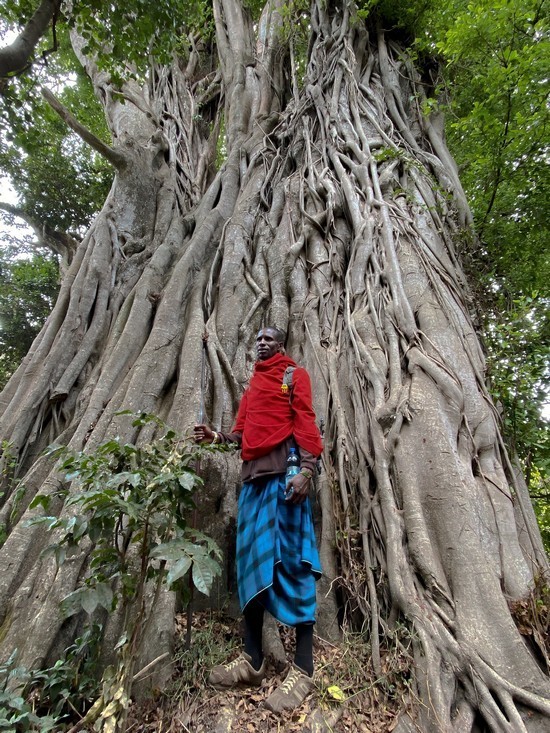 Maleton Oleriro, a
Maasai warrior, pauses while guiding a group down the forested slopes of the
Empakaai Crater in Tanzania on November 11, 2022.
Maleton Oleriro, a
Maasai warrior, pauses while guiding a group down the forested slopes of the
Empakaai Crater in Tanzania on November 11, 2022.
The 45-minute bucking bronco of a ride down the rim ended at
a marsh, where we ate a tasty boxed lunch of mustard-ginger chicken stew. We
gazed at a submerged hippo, a few curly horned buffalo, and a wandering
warthog. As we jolted along a corrugated path past a line of pale pink
flamingos in the shallow lake, a troop of baboons along the roadside, and a
herd of diminutive Thomson gazelle in the scrub, two things became apparent:
The crater was mostly empty, and the wildlife was doing a lot of loitering.
We rumbled up out of the amphitheater just before sunset and
pulled into a glade near a Maasai village. One of its warriors, Maleton
Oleriro, tall and draped in a red blanket, would be our guide for the next two
days. We talked as the fire of damp wood hissed and smoked.
Maleton told us how his late father had six wives, how his
own arranged marriage three years ago included a dowry of 20 cows, and how he
trained to be a Maasai warrior with other boys by practicing spear-throwing
while herding cows.
The next morning, we rattled over to the rim of Empakaai
Crater, an enchanting circular caldera about 4 miles wide and 304m deep,
largely covered by a lake. The wind, sun and clouds created an impressionistic
canvas on the gleaming surface.
We traipsed down a steep, dusty path, through a thick
forest, and onto a shoreline of stubby grass and sand. We were alone but for
several thousand flamingos rimming the edge of a quarter of the deep lake in a
pink arc.
We hiked for four hours toward another Maasai village,
joined by five women selling bracelets and carrying firewood. They sang a song
of praise and fertility as we walked amid a primeval panorama of mountain
ranges and a dazzling rainbow arcing toward our ultimate point, the Ol Doinyo
Lengai volcano.
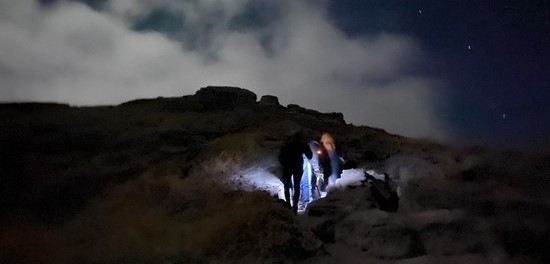 Close to the summit
of Ol Doinyo Lengai, in Tanzania on November 13, 2022.
Close to the summit
of Ol Doinyo Lengai, in Tanzania on November 13, 2022.
The next day, our tents and gear saddled on two small
donkeys, we embarked on an all-day hike — across a misty valley, through an
ashy acacia forest, and onto an escarpment that ran for miles down through the
mountainscape. As a massive curtain of clouds lifted, we could see part of the
Serengeti plains far beyond on the left, the sled-shaped Lake Natron way off in
front, and the remote volcano to our right, its top crowned with a cloud mass
bigger than the mountain.
We stopped in a dry riverbed with stratified walls and
shared our beef stew with five passing Maasai boys. They all wanted to be
warriors like Maleton, and we took turns launching a walking pole down the
ravine in a spear-throwing contest. Kaixu and I came in last. In the afternoon,
we reached the bottom and waited on a hillock for Aidano to drive us to Lengai
Safari Lodge.
A sandstorm was building, horizontal whirlwinds racing down
the canyon and obscuring the lake in the distance. A Land Cruiser finally
arrived, but it was driven by Dennis, the Maasai guide who would take us up the
volcano. Aidano had gotten stuck in deep ash a few miles away. We rumbled over
and spent 20 minutes pushing and towing Aidano’s truck out of the depression.
That night we dined on a local dish called ugali, a
polentalike mash that you ball to sop up stew with your fingers, and washed it
down with Kilimanjaro lager.
After spending the next morning swimming at a crystalline
waterfall near the lodge, we rested and at 10:30 p.m. headed out to Ol Doinyo
Lengai. Volcanologists estimate that the volcano started forming some 370,000
years ago. Explosive eruptions come every generation or so, with the last one
occurring in 2007 and 2008.
We scrambled up to the rim just before the sun broke the
horizon next to Kilimanjaro. In a whipping wind, we looked down about 20
stories into an entrancingly beautiful cauldron of rising steam and sputtering
lava.
The crater was about 200 yards across, stratified brownish
cliffs encircling a moonscape of rough formations and sculpted hornitos in
multiple shades of gray and white. Columns of gas rose from vents around the
circle. In the middle, surrounded by arabesque flats that looked like crusted
lakes, loomed a profusion of large cones, with jagged holes at the tops. The
largest one was smooth and gray, and when the wind died down we could hear lava
churning and spitting like some seething creature from the netherworld. Every
minute or so, bursts of black beads splashed out of the hornito, tumbling down
the sides.
I jogged briefly around the rim, stopping to contemplate the
molten energy that shaped these highlands, and hoping for a nonfatal, but
sizable, eruption. But after about an hour, it was time for the teetering
six-hour descent. The rising sun, heating the entombed lava slopes, was casting
a pyramid shadow over the landscape far below.
Read more Travel
Jordan News










